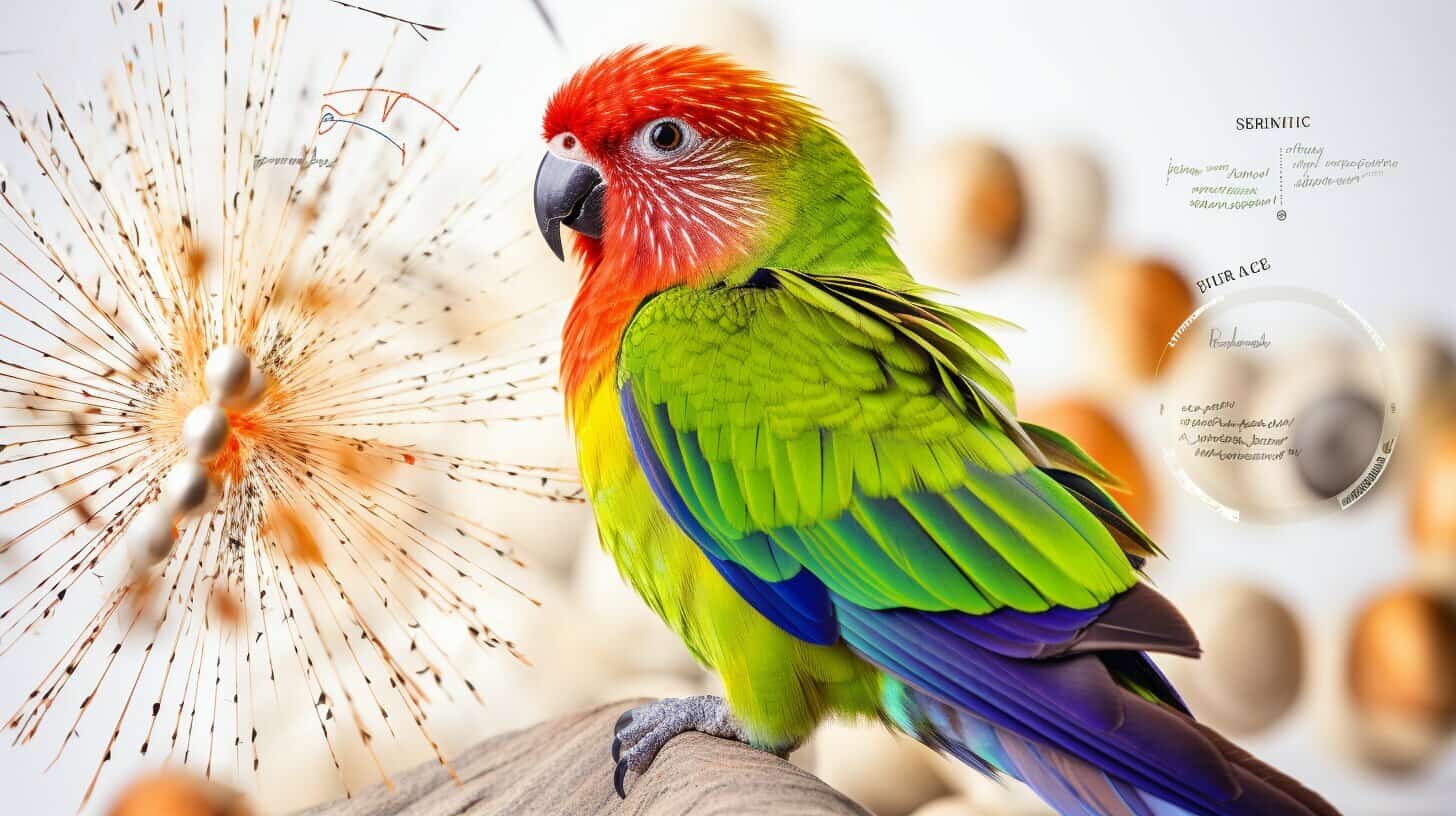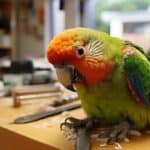Kakariki are charming and intelligent parrots that make great companions. However, feather loss is a common concern among owners, and it can be caused by a variety of factors. Understanding these causes is crucial to providing your feathered friend with the right care and treatment.
This article will explore why your kakariki might be losing feathers and provide effective solutions to prevent and treat this issue. From nutritional deficiencies to environmental factors, we will cover everything you need to know to ensure your bird’s feather health.
Why is My Kakariki Losing Feathers? Your Kakariki may be losing feathers due to moulting, a natural process in many birds. Moulting is when birds shed old or damaged feathers to make way for new ones. However, other factors such as stress, dietary deficiencies, or underlying health issues can also lead to feather loss in Kakarikis. Observing the bird’s behaviour, its environment, and its diet can give insights into the root cause. If feather loss is excessive or if there are other worrying signs, it’s essential to consult with an avian veterinarian.
Key Takeaways:
- Feather loss is a common issue in kakariki.
- Understanding the causes behind feather loss is crucial to providing the right care and treatment.
- This article will explore the various reasons for feather loss and provide effective solutions to prevent and treat this issue.
Understanding Normal Moulting Process in Kakariki
Like all birds, a Kakariki goes through a natural process of moulting, which involves losing old feathers and growing new ones. Moulting is a regular and essential part of a bird’s life cycle, and it usually occurs annually or bi-annually, depending on the species and age of the bird.
During moulting, a Kakariki may appear to be losing feathers rapidly, which can concern owners. However, it is crucial to understand that this is a normal process, and it is nothing to worry about if the bird is otherwise healthy and showing no signs of distress.
The Stages of Moulting in Kakariki
The moulting process in kakariki typically involves three stages:
- Pre-basic moult: This is the initial stage of moulting, during which the bird sheds its older feathers and replaces them with new ones. This stage is characterised by losing feathers in the bird’s head, neck, chest, and tail regions.
- Basic moult: In this stage, the bird moults its flight feathers, which are the primary feathers that provide lift and enable flight. This stage is the most prolonged and challenging, as the bird cannot fly until the new feathers grow and mature.
- Pre-alternate moult: During this stage, the bird’s feathers grow to their full length and regain their vibrant colouration. This stage marks the end of the moulting process, and the bird returns to its usual appearance and functions.
It is essential to note that moulting is a gradual and continuous process that can last for several weeks or even months. During this time, the bird may appear scruffy or unkempt, and behaviour may change, but this is normal and nothing to worry about as long as the bird is eating, drinking, and otherwise healthy.
In case you observe any unusual or concerning behaviour in your kakariki, it is advisable to consult an avian veterinarian to rule out any underlying health issues or complications.
Nutritional Deficiencies and Feather Loss
Kakarikis require a balanced diet of vitamins, minerals, and protein to maintain healthy feather growth. Nutritional deficiencies can lead to feather loss or other health issues.
The most common nutrient deficiencies that affect feather health are protein, calcium, and vitamins A, D, and E. A low-protein diet can cause feathers to become brittle and prone to breakage, while a lack of calcium can result in weak and thin feathers. Vitamins A, D, and E ensure healthy skin and feathers. A deficiency in these vitamins can result in dry, itchy skin and brittle feathers.
A varied diet with a mix of seeds, pellets, fresh fruits, and vegetables is crucial for optimal feather health. Leafy greens, such as kale, spinach, and broccoli, are excellent sources of calcium, vitamin A, and other essential nutrients. Carrots, sweet potatoes, and mangoes are rich in vitamin A, while fatty fish like salmon and sardines are high in vitamin D and E.
Supplementing their diet with a high-quality bird multivitamin can also be helpful, especially during stress or illness. However, it is crucial to consult with an avian veterinarian before adding any supplements to your kakariki’s diet as excessive amounts of some nutrients can be harmful.
Stress and Feather Plucking in Kakariki
Kakariki, like all birds, can experience stress which may lead to feather plucking. Stress can arise from various sources, such as environmental changes, lack of stimulation or attention, or social interactions with other birds or humans.
In some cases, feather plucking can become a habit and develop into a compulsive behaviour, significantly damaging the bird’s plumage and skin. Feather plucking can also respond to physical discomfort or illness, so it’s important to rule out any underlying medical conditions.
If you notice your kakariki is showing signs of stress or starting to pluck their feathers, there are some steps you can take to reduce stress levels and promote healthy feather growth:
- Provide a spacious cage that allows the bird to move freely and engage in natural behaviors such as flying and foraging
- Offer a variety of toys, puzzles, and perches to provide mental stimulation and prevent boredom
- Ensure the bird receives a balanced diet of vitamins, minerals, and protein. A poor diet can contribute to stress and feather plucking.
- Provide regular social interaction and positive reinforcement to build trust and confidence.
- Minimize exposure to loud noises, bright lights, or other potential stressors.
If feather plucking persists despite these measures, it’s important to seek advice from an avian veterinarian. They can help identify any underlying medical conditions and offer specialized treatments to promote healthy feather growth.
Remember, a happy and healthy kakariki is less likely to experience stress and feather plucking. So, by providing a nurturing and stimulating environment, you can help prevent feather loss and promote overall well-being in your feathered friend.
Feather Mites and Parasites
Feather mites are common external parasites that can infest kakariki and lead to feather loss. These tiny arachnids can be difficult to detect but can cause significant damage to a bird’s feathers and skin if left untreated.
If you suspect that your kakariki has feather mites, it is important to take immediate action to prevent the infestation from spreading. The first step is to isolate the affected bird from other birds and animals to prevent the mites from spreading. You should also thoroughly clean and disinfect the bird’s cage and any accessories, such as perches or toys, that may have come in contact with the mites.
There are several treatment options available for feather mites, including topical sprays and powders that can be applied directly to the bird’s feathers. It is important to follow the instructions carefully and to continue treatment for the recommended duration to ensure that all mites have been eliminated.
In addition to feather mites, kakariki can also be affected by other external parasites, such as lice and mites. If left untreated, these parasites can cause itching, irritation, and feather loss. Regular cleaning and grooming routines can help prevent infestations, but if you suspect that your bird has an infestation, it is important to seek veterinary care. Your veterinarian can recommend an appropriate treatment plan and provide guidance on preventing future infestations.
Infections and Diseases Affecting Feather Health
Infections and diseases can also cause feather loss in kakarikis. As these birds are prone to certain avian illnesses, their owners must be aware of the potential risks and take necessary precautions.
One common disease that can impact feather health is Psittacine Beak and Feather Disease (PBFD). This viral infection is highly contagious and can lead to feather loss, beak and nail deformities, and even death in some cases. The best way to prevent PBFD is to ensure that kakariki are obtained from reputable breeders or sources and to have newly acquired birds tested for the virus before introducing them to the flock.
Other viral infections, such as Avian Influenza and Newcastle Disease, can also lead to feather loss in kakariki. These diseases typically cause respiratory symptoms in birds and can be transmitted through contact with contaminated objects or infected birds. Owners should prioritize good hygiene and sanitation practices to minimize the risk of transmission and seek prompt veterinary care if any signs of illness arise.
Bacterial infections, such as feather follicle infections, can also affect feather health. These infections can lead to redness, swelling, and discharge around the feather follicles, resulting in loss. Maintaining good sanitation and hygiene practices, providing a balanced diet, and minimizing stress can help prevent these infections. If feather loss persists or is accompanied by other symptoms, owners should consult an avian veterinarian for diagnosis and treatment.
Prevention and Treatment
The key to preventing infections and diseases that impact feather health is to prioritize preventive measures, such as good hygiene and sanitation practices, proper nutrition, and stress reduction techniques. Owners should also be vigilant for any signs of illness in their birds and seek prompt veterinary care.
If a bacterial infection is suspected, treatments such as antibiotics and topical ointments may be prescribed by a veterinarian. In cases of viral infections, supportive care and symptom management may be the only options available. In some cases, the infected bird may need to be quarantined to prevent the spread of the disease to other birds.
Environmental Factors and Feather Loss
In addition to diet and stress, environmental factors can also impact a kakariki’s feather health. These birds come from New Zealand, where the climate is mild and humidity levels are high. They are, therefore, sensitive to changes in temperature and humidity.
Maintaining a comfortable living environment for kakariki is essential to prevent feather loss. The ideal temperature range is between 18 and 24 degrees Celsius, and humidity should be between 50% and 70%. Too much humidity can lead to fungal infections, while low humidity can cause dry skin and feathers.
A well-ventilated living space is also crucial for healthy feathers. Poor air quality can cause respiratory problems and irritate a bird’s skin, leading to feather plucking and loss. Kakarikis need fresh air and proper ventilation to thrive.
Finally, lighting is another critical factor in feather health. Kakariki require natural light or full-spectrum light to support feather growth and prevent dull, discoloured feathers. Avoid exposing them to direct sunlight, harming their eyes and skin.
By controlling these environmental factors, kakariki owners can provide optimal living conditions to support healthy feather growth and prevent feather loss.
Other Possible Causes of Feather Loss in Kakariki
While nutritional deficiencies, stress, parasites, diseases and environmental factors are the most common causes of feather loss in kakariki, other factors could be responsible. These factors are less common but still worth considering if the bird is experiencing feather loss that the aforementioned factors cannot explain.
Hormonal Imbalances
Kakarikis, like all birds, has complex hormonal cycles that can be disrupted by various factors, such as lighting and diet, which could lead to feather loss. If hormonal imbalances are suspected, it is advisable to consult a veterinarian with avian experience for a proper diagnosis and treatment plan.
Age-related Changes
As kakariki age, their feathers may become less vibrant and may not grow back as quickly as they used to. This is a natural part of the ageing process and does not necessarily indicate anything wrong with the bird’s health. However, if feather loss in a senior kakariki is sudden and excessive, it is advisable to seek veterinary attention.
Genetic Predispositions
Sometimes, feather loss in kakariki can be linked to genetics. If the bird’s parents or siblings had similar issues, the bird may have inherited a predisposition for feather loss. While there may not be a cure for a genetic predisposition, measures can still be taken to promote healthy feather growth and minimize feather loss.
It is important to observe the bird’s overall health and behaviour to ascertain the cause of feather loss. If any concerns are identified, it is advisable to seek veterinary attention promptly to ensure the bird’s well-being.
Implementing Preventive Measures for Feather Loss
Preventing feather loss in kakariki requires a proactive and comprehensive approach. Owners must ensure that their birds receive a balanced and varied diet that includes fresh fruits and vegetables, high-quality seed blends, and protein-rich foods like cooked egg or tofu.
Regular grooming is also crucial for maintaining healthy feathers. This includes providing your kakariki with regular baths or showers to keep their feathers clean and well-hydrated. Additionally, you should trim their nails and beak as needed to prevent them from causing damage to their feathers.
Stress reduction techniques can also help prevent feather loss in kakariki. This can involve creating a peaceful and enriched living environment, providing toys and perches, and avoiding sudden changes in routine or environment.
Keeping your kakariki’s cage clean is also important for good feather health. This involves regular spot cleaning, weekly deep cleaning, and ensuring the cage is well-ventilated and free of toxins or irritants.
Finally, observing your kakariki’s behaviour and overall health is essential for identifying any underlying issues contributing to feather loss. If you notice any changes in appetite, energy level, or behaviour, it’s essential to seek professional help from an avian veterinarian.
Seeking Professional Help
If feather loss persists despite implementing preventive measures, or if other concerning symptoms accompany it, it is crucial to seek professional help from an avian veterinarian. A comprehensive examination can help identify any underlying health issues contributing to the feather loss and guide the development of a tailored treatment plan.
When choosing an avian specialist, looking for a reputable and experienced practitioner with expertise in caring for kakariki is essential. If necessary, they should be able to perform a thorough physical examination and diagnostic tests, such as blood work and skin scrapings.
A qualified avian veterinarian can provide advice on nutrition, grooming, and environmental management specific to your kakariki’s needs. They can also prescribe medication or other treatments to address underlying health issues contributing to feather loss.
Regular check-ups with an avian veterinarian are essential for maintaining the overall health and well-being of your kakariki, and they can help catch any potential health issues before they become more severe.
Conclusion
Feather loss is a common concern among kakariki owners, but identifying the underlying causes and implementing preventative measures can greatly improve a bird’s feather health. As explored in this article, feather loss can be attributed to various factors, such as moulting, nutritional deficiencies, stress, parasites, infections, environmental factors, and other possible causes.
Owners need to provide their kakariki with a balanced and nutritious diet, regular grooming and cleaning routines, and a stress-free and enriched environment. Seeking professional help from an avian veterinarian is also recommended if feather loss persists or is accompanied by other concerning symptoms.
By understanding the causes and taking preventive measures, kakariki owners can promote healthy feather growth and overall well-being in their feathered companions. Remember, a holistic approach is key to ensuring optimal feather health and a happy, healthy bird.
FAQ
Q: Why is my kakariki losing feathers?
A: Feather loss in kakariki can have various causes, including natural moulting, nutritional deficiencies, stress, parasites, infections, environmental factors, and other underlying health issues.
Q: What is the normal moulting process in kakariki?
A: Kakarikis go through a natural moulting process where they shed and grow old feathers. Rapid feather loss during moulting is normal and should not cause concern.
Q: Can nutritional deficiencies contribute to feather loss in kakariki?
A: Yes, nutritional deficiencies can affect feather health in kakariki. A balanced diet rich in vitamins, minerals, and protein is important for healthy feather growth.
Q: How does stress affect feather plucking in kakariki?
A: Stress can lead to feather-plucking behaviour in kakariki, which can cause feather loss. Creating a stress-free and enriched environment for kakariki can help prevent this issue.
Q: Can parasites cause feather loss in kakarikis?
A: Yes, external parasites such as feather mites can infest kakarikis and lead to feather loss. Regular cleaning and grooming routines are essential for maintaining good feather health.
Q: Can infections and diseases affect feather health in kakarikis?
A: Yes, infections and diseases can impact a kakariki’s feather health. Regular veterinary check-ups are important to prevent, diagnose, and treat any underlying health issues.
Q: How do environmental factors contribute to feather loss in kakariki?
A: Environmental factors such as temperature, humidity, and air quality can affect feather health in kakariki. Creating an optimal living environment with proper cage setup, ventilation, and lighting is crucial.
Q: What are other possible causes of feather loss in kakarikis?
A: Less common causes of feather loss in kakariki include hormonal imbalances, age-related changes, and genetic predispositions. Observing the bird’s overall health and behaviour is important to identify underlying issues.
Q: How can I prevent feather loss in my kakariki?
A: To prevent feather loss, ensure your kakariki has a balanced diet, regular grooming, reduced stress levels, and a clean living environment. Taking a holistic approach is key to optimal feather health.
Q: When should I seek professional help for my kakariki’s feather loss?
A: If feather loss persists or is accompanied by other concerning symptoms, it is recommended to seek professional help from an avian veterinarian. They can provide a comprehensive examination and tailored treatment plan.



Have comments or questions about this article? Then get involved!
Spotted an error or something we have missed? Let us know